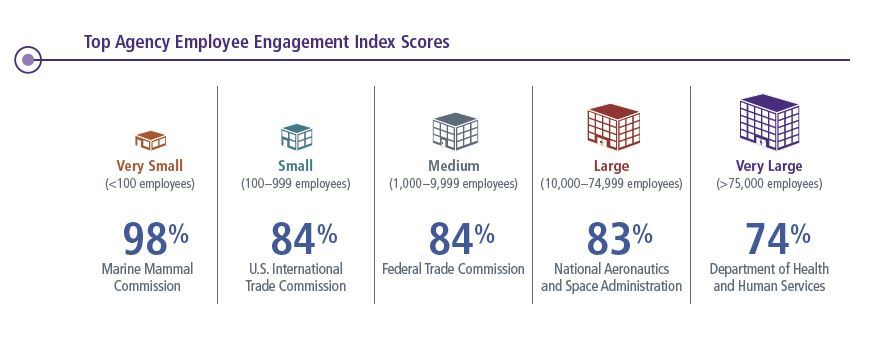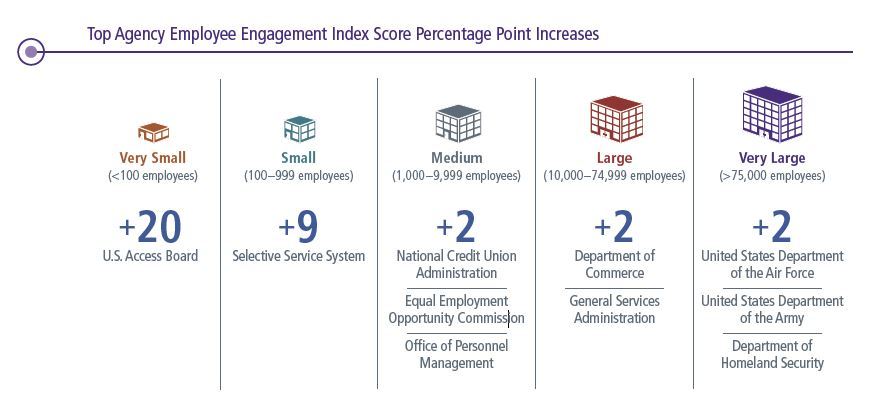

Employee engagement held steady across the federal workforce at 68%, according to the newly released results of the Federal Employee Viewpoint Survey.
Best listening experience is on Chrome, Firefox or Safari. Subscribe to Federal Drive’s daily audio interviews on Apple Podcasts or PodcastOne.
Employee engagement in the federal workforce held steady in 2019, ending a five-year trend of 1% increases across government, according to the results of this year’s Federal Employee Viewpoint Survey (FEVS).
The results, which the Office of Personnel Management published Thursday, show overall employee engagement stayed flat at 68% across government in 2019.
That stability, OPM said, was a nice surprise, especially given the partial government shutdown, budget constraints and other events that could have put a dent in employee engagement in 2019.
“It’s actually a really good thing from my perspective,” Kim Wells, acting director of OPM’s Office of Strategy and Innovation, told reporters. “It speaks to the resilience of the workforce and the stability in scores. It also very much speaks to the concerted effort that we’ve seen, especially as I look at scores within individual agencies.”
Common themes from previous year’s surveys, which are designed to take the pulse of employee satisfaction of their jobs, workplaces and agency leadership, continued in 2019.
Federal employees continue to feel strongly passionate about their work: 96% said they’re willing to put in extra work to get the job done and 90% said the work they do is important.
Employees continue to have negative perception of their agency’s ability to deal with poor performers.
About 34% of federal employees said they believe their agencies take steps to deal with a poor performer who can’t or won’t improve, up slightly from last year’s score of 32%.
As a follow up, OPM added a new question this year, which assessed employees’ perception of the specific steps they believed their agencies took to manage poor performers. A clear majority, or 56% of respondents, said poor performers continue to remain in their work units and continue to under-perform, while 17% said poor performers stay in the work unit and do manage to improve.
Roughly 8% said poor performers are removed or transferred, and just 2% said these poor performers leave. About 17% said there are no poor performers in their work units.

About 39% of the workforce said promotions in their work unit are based on merit, while 39% said their agencies recognize differences in performance in meaningful ways.
Wells said OPM has found a strong correlation between positive perceptions of performance management and opportunities for training and employee engagement.
The Trump administration has used this data in particular as evidence for changes to existing performance management procedures over the past year.
Meanwhile, 41% of the federal workforce said they believe the survey results will be used to make their agencies better places to work, a figure that held steady from the previous year’s survey.
“I believe that the agencies that are most successful are those who use the data as starting points for analysis and action,” OPM Director Dale Cabaniss wrote in a message accompanying the report. “It’s not about seeing percentages move but creating a more conducive environment for employment. I will look into these issues with the OPM FEVS results as data-based evidence prompting future action.”
Participation in this year’s FEVS improved slightly. A total 615,295 employees, or 42.6% of the federal workforce, responded this year. By comparison, a little less than 41% of the workforce responded to the 2018 survey.
This was the second year OPM administered the FEVS as a census rather than a sample, meaning all eligible employees had an opportunity to take it. OPM sent the survey to employees between May and July.
Individually though, many agencies made large strides to improve their response rates over the past year. Participation on the 2019 FEVS skyrocketed by 26 points at the National Credit Union Administration. The Department of Health and Human Services improved its participation rate by 15 points this year. Nearly three-quarters, or 72% of the HHS workforce, completed the 2019 FEVS, a feat for an agency of its size.

In some cases, high participation rates on the FEVS also translated to top engagement scores. HHS, for example, sits at the top among very large agencies with an engagement score of 74%.
HHS, Wells said, has mastered the art of the “feedback loop,” sharing the FEVS results with the workforce, using the results to take action and then soliciting feedback on those new initiatives.
OPM created an employee engagement toolkit, which it released to agencies last month, that urges organizations to use FEVS data to create workforce action plans.
NASA, once again, is at the top of the pack among agencies of its size with an 83% score.
The Marine Mammal Commission, an agency of less than 100 employees, earned a nearly perfect score of 98% in 2019. According to the FEVS, all commission employees took this year’s survey.
 And several agencies made small improvements over the previous year.
And several agencies made small improvements over the previous year.
The departments of the Army and Air Force each improved engagement by two points in 2019. The Department of Homeland Security continued its upward trend this year; it also improved by two points.
“Increases in scores at some of the very large and large agencies, I take that to be a huge win,” Wells said. “When you try to change the hearts and minds of a lot of people, that’s difficult to do.”
OPM itself saw a two-point bump in 2019, as well as the General Services Administration, Commerce Department and Equal Employment Opportunity Commission.
The U.S. Access Board managed to improve employee engagement by 20 points over the previous year.

For the first time, OPM included new questions designed to measure the impact of the most recent partial government shutdown on employee engagement.
Wells said several agencies asked OPM to include these questions on the 2019 FEVS.
“To me this was something we absolutely had to do,” she said. “Because when sequestration occurred in 2013 and 2014, we saw a decline, a pretty marked decline in a lot of instances in engagement scores and global satisfaction. But what we didn’t have was any evidence. All I could ever do was speculate.”
The data includes employees who worked for agencies who had full funding and were not impacted by the partial government shutdown.
According to the 2019 FEVS, 46% of federal employees were impacted by the most recent government shutdown. They either worked during part of, or all of the shutdown and weren’t paid until the lapse ended, or they had no work and no pay for the whole thing, the survey said.
For impacted employees, a majority, or 67%, said the partial government shutdown had the biggest impact in delaying their work. About 48% said the shutdown reduced customer service levels.
Interestingly enough, OPM also asked federal employees to comment on whether the government shutdown influenced their search for another job.
According to the survey, 71% of all FEVS respondents said they weren’t looking for a job. Just 2% said they were specifically looking for another job because of the government shutdown, while 8% said the lapse was one of several reasons for their job search.
About 20% of all FEVS respondents acknowledged they were looking for another job but the shutdown had no influence.
Copyright © 2024 Federal News Network. All rights reserved. This website is not intended for users located within the European Economic Area.
Nicole Ogrysko is a reporter for Federal News Network focusing on the federal workforce and federal pay and benefits.
Follow @nogryskoWFED
